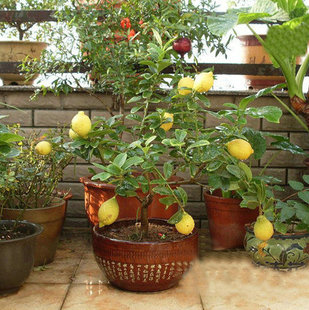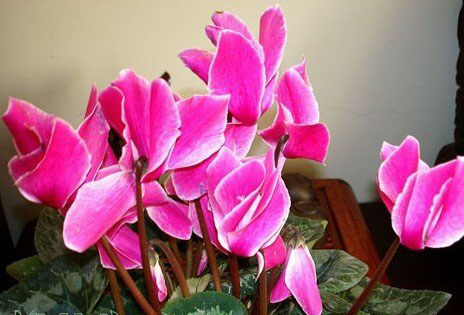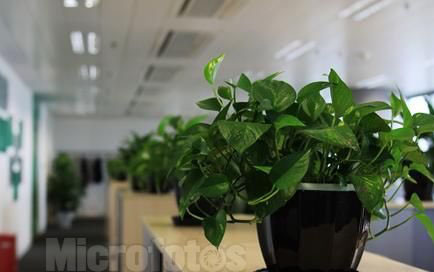What about the fruit drop of potted lemon?
Many flower friends like potted lemon trees, which can not only be used as potted plants, but also hope to be covered with lemons, but some flower friends find that their own lemons hang fruit, but they have fallen fruit again, so they don't know what to do.
Flower friend asked: my family bought lemons 3 years ago, every year the fruit is as big as fingernails and falls,-there are no left, how is this going on?
Answer: lemon fruit drop is mainly caused by improper cultivation and management, weak tree growth and poor nutrients. Before flowering and after hanging fruit, lemon needs to be topdressing several times, applying compound fertilizer once a month, spraying flower nutrient solution once a month, and sparse flowers and fruits to protect fruit. First, too many and too dense buds are removed, and then when the young fruit is 1 cm in size, part of the fruit is removed; after physiological fruit drop, the fruit is determined according to the leaf-fruit ratio of 30 to 40 purl, and the weak branches are not left.

What about the fruit drop of potted lemon?
Lemon
Lemon is a small evergreen tree with small leaves but plump pulp. It is a widely used fruit, which can be sliced and soaked in water after ripening, fruit juice can be cooked, and lemon oil can be extracted from the peel. It is not recommended to eat as fruit because of its sour taste. Lemon is only suitable for cultivation in the south because of its origin, although there will be fruit drop problems in the process of cultivation to meet this requirement. So what should I do when this happens to lemons?
What are the reasons for the fruit drop of potted lemon
1. Watering is too frequent and there is stagnant water at the bottom of the basin, so the number of watering should be reduced.
two。 The watering is impermeable, the bottom of the basin soil is dry, and the skin is moist. Watering should follow the principle of "watering thoroughly".
3. Fertilization is not in place, can not apply a single fertilizer, should be frequently applied mixed fertilizer.
4. Lack of light, of course, exposure is not good, should be given reasonable light.
5. The growth environment is too hidden and the ventilation is poor, so natural ventilation should be strengthened.
Lemon
Second, how to make lemons fruitful
1. Light
We need to know that lemons like to grow in a warm and humid environment, so give lemons all-day light as much as possible when potted, but avoid strong direct sunlight after flowering to fruiting, otherwise it is easy to cause normal flowering and hinder fruit hanging.
two。 Watering
Lemon has a high demand for water during the period of growth and development, but unscientific watering is disadvantageous to the growth of lemon, so watering is best carried out according to seasonal changes, more watering in dry season and proper watering in cool season. In the harvest season, sufficient soil moisture should be kept in order to ensure the sound development of the fruit, and the basin soil should be kept dry before overwintering, so that the lemon can survive the winter smoothly.
3. Fertilizer application
Lemon likes fertilizer, so sufficient base fertilizer should be applied before potting and changing pots, and the principle of "applying thin fertilizer frequently" should be followed during the growing period. Lemons planted in pots in northern China can be properly treated with acidic nutrient solution due to the problem of partial alkali in the soil, which is beneficial to the normal flowering and fruit hanging of lemons.
4. Artificial pollination
Usually, butterflies and bees in nature pollinate lemons after flowering, but in order to improve the hanging rate, artificial pollination is needed, and the best time for pollination should be around 09:00 every morning. Pollination is carried out after the petals are fully extended.
5. Elimination of dense and dysplastic fruits
The fruit of lemon is mostly a good thing, but when the nutrition transported by the plant is not enough to absorb the fruit, it is easy to lead to the problem of grabbing nutrients between the fruits, which will not only bring burden to the plant but also make the fruit underdevelopment. therefore, it is necessary to remove some buds before the flowers are fully blooming, and then pick some dense young fruits when hanging the fruit.
6. Change the basin
The purpose of changing the basin is to make lemons grow more healthily, so turning the basin, changing soil, pruning, fertilizing and so on should be carried out at the beginning of spring every year. First cut off some old branches and leaves, diseased branches and leaves, and overgrown branches and leaves before changing the basin.
How do potted lemons fall fruit? many flower friends like potted lemon trees, which can not only be used as potted plants, but also hope to be covered with lemons, but some flower friends find that their lemons have hung fruit, but they have fallen fruit again. I don't know what to do. Flower friend asked: my family bought lemons 3 years ago, every year the fruit is as big as fingernails, there is no one left, how is this? Answer: lemon fruit drop is mainly caused by improper cultivation and management, weak tree growth and poor nutrients. Before flowering and after hanging fruit, lemon needs to be fertilized many times, compound fertilizer is applied once a month, flower nutrient solution is sprayed once a month, and fruit thinning measures should be taken to protect fruit. First, remove too many and too dense buds, then remove part of the fruit when the young fruit is 1 cm in size; after physiological fruit drop, set the fruit according to the leaf-fruit ratio of 30 to 40:1, leaving no weak branches.
- Prev

How to save wilted flowers
The wilting phenomenon of flowers is the biggest headache for flower growers. There are many reasons for flower wilting, such as lack of water, fertilizer, light, temperature, inadaptability to pH in soil, excessive application of chemical fertilizer, infection with virus, damage by insect pests and poisonous gases in the air, etc.
- Next

What if the green plants in the office turn yellow?
Some company office green plants are bought and need to be maintained by themselves. They often find that the office green plants turn yellow for no reason, mainly because the environment of the office is different from that of the home, so it causes the green plants to turn yellow. It is necessary to solve the problem that green plants in the office turn yellow.
Related
- Fuxing push coffee new agricultural production and marketing class: lack of small-scale processing plants
- Jujube rice field leisure farm deep ploughing Yilan for five years to create a space for organic food and play
- Nongyu Farm-A trial of organic papaya for brave women with advanced technology
- Four points for attention in the prevention and control of diseases and insect pests of edible fungi
- How to add nutrient solution to Edible Fungi
- Is there any good way to control edible fungus mites?
- Open Inoculation Technology of Edible Fungi
- Is there any clever way to use fertilizer for edible fungus in winter?
- What agents are used to kill the pathogens of edible fungi in the mushroom shed?
- Rapid drying of Edible Fungi

